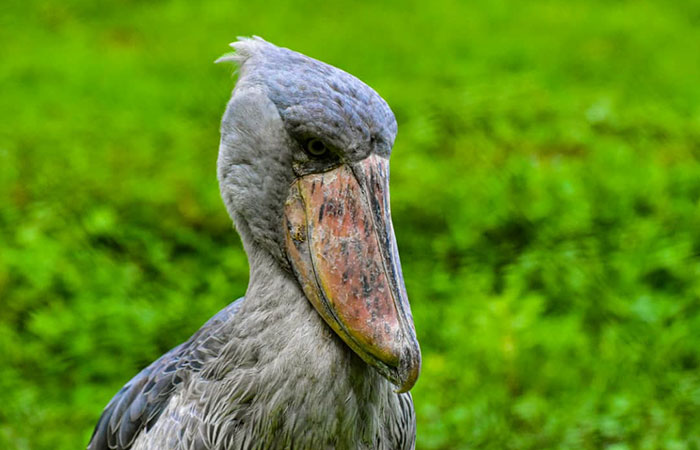Our 1 day Mabamba for shoebill birding, Mabamba Swamp is located on the Northern shore of Lake Victoria 12 kilometers West of Entebbe. Bird Life International recognizes Mabamba swamp as an important Birding Area (IBA). This is one of the most visited tourist sites most especially bird lovers who come for tours into the Pearl of Africa because of its strategic location. Considered as home to over 300 bird species, the most notable bird here is the shoebill. The shoebill derives its name from the structure of its beak.
Detailed 1 day Mabamba shoebill birding itinerary.
Day 1: Transfer to Mabamba swamp for shoebill birding
After served breakfast, go for a trip to Mabamba swamp for shoebill birding. This is one of the most notable activities carried out in Mabamba swamp. located on the northern shore of Lake Victoria, Mabamba Swamp is just 12km west of Entebbe. Mabamba will captivate birders and non-birders alike. The wetland is Uganda’s most important birding site, and it is home to over 300 bird species. Mabamba is an area of immense ecological importance. In 2006, the Ramsar Convention on Wetlands awarded Mabamba Swamp the status of a ‘Wetland of International Importance’ since it contains globally threatened species.
Birdlife International recognizes the Mabamba Swamp as an Important Bird Area (IBA).
Mabamba Bay Swamp in Uganda is a prime wetland birding site famous for the Shoebill which is Uganda’s most sought-after bird by Uganda birding tourists as well as by nature lovers. Mabamba Swamp is located west of Entebbe on the northern shore of Lake Victoria, covering 2424 ha with thick marshes of papyrus, water lilies and other wetland grasses.
Mabamba swamp is a Ramsar site and Important Bird Area (IBA). The wetland hosts over 300 bird species that include many globally threatened species, 7 of Uganda’s 12 Lake Victoria biome restricted species (notable is the Papyrys Gonolek) and plenty of wetland specialties. The wetland also hosts huge flocks of Paleartic migrants every year from October to March.
Mabamba Swamp can be reached by a number of routes. From Kampala or Entebbe, the easiest route is via the Nakiwogo landing site in Entebbe where you take a 10-minute ferry crossing to Kasanje landing and from there drive for about 20 minutes to Mabamba passing through cultivations and open fields that will provide plenty of garden birds.
Birding in Mabamba swamp is done from a motorized wooden boat by riding through a maze of trails cutting through the thick marshes. Mabamba wetland is popular for the Shoebill which is the most sought-after bird by birdwatchers in Uganda. The Shoebill is also on the wildlife list of non-bird watching tourists that are intrigued by its peculiar looks and massive size. The rare bird is found in few places in Uganda and Mabamba Swamp is the most accessible and reliable with the best chances of seeing the Shoebill in Uganda and arguably in Africa.
Mabamba Swamp is rich with lungfish (called “mamba” in native language) which is the favorite food for the Shoebill. However, the lungfish is also one of the most sought-after fish by the local fishermen, creating competition with the Shoebill. The fishermen had long held a superstition that seeing a Shoebill (locally called ‘Boolwe’) resulted in a poor catch that day. But this not farfetched because the Shoebill feeds on lungfish and where the Shoebill is the fish will go into hiding.
For the fishermen it was a bad omen to see a Shoebill when one set out to fish in the wetland. They hunted the Shoebills and killed them, leading to a decline in the numbers and almost rendered them extinct in the wetland. Designating the wetland a Ramsar site in 2006 provided some protection to the Shoebill. However, bird watching on the wetland brought about enlightenment to the fishermen and community.
The fishermen rent out their boats to birdwatchers and make a lot of money, and even some fishermen have been trained in birding and guiding. The fishermen now protect the Shoebill, so that when they set out to fish and see a Shoebill, they do not move too close not to disturb it and will gladly inform the tourists of where to see it. There is about 12 Shoebills said to be resident in Mabamba wetland.
The best time to see the Shoebill in Mabamba swamp is early morning, say 7am, before there is more activity on the wetland BUT also by this time the Shoebill is hunting for lunch fish which it does by standing in one place for a long time or even hours looking out in the water waiting for fish to cross so it scoops it with the big strong shoe-like bill that breaks the fish instant.
Other Mabamba Swamp birds
African Fish Eagle, Purple Swamphen, African Green Pigeon, African Jacana, African Marsh Harrier, African Pigmy Goose, Black Crake, Black Heron, Black-crowned Night Heron, Black-crowned Waxbill, Black-headed Heron, Black-winged Stilt, Blue Swallow, Blue-cheeked Bee-eater, Cattle Egret, Common Moorhen, Common Sandpiper, Common Sqacco Heron, Double Toothed Barbet, Glossy Ibis, Goliath Heron, Great Cormorant, Great White Egret, Great White Pelican, Green Cuckoo, Grey Heron, Grey-crowned Crane, Gull-billed Tern, Hadada Ibis, Harmerkop, Little Egret, Little Stilt, Long-tailed Cormorant, Long-toed Lapwing, Malachite Kingfisher, Marsh Harrier, Northern Brown-throated Weather, Orange Weaver, Papyrus Gonolek, Pied Kingfisher, Pied Wagtail, Pink-backed Pelican, Pin-tailed Whyda, Purple Heron, Red-eyed Dove, Red-headed Love-bird, Shining Blue Kingfisher, Speckled Mousebird, Spur-winged Goose, Spur-winged Lapwing, Swamp Flycatcher, Veilots’ Black Weaver, Village Weaver, Water Thicknee, White-browed Cuckoo, White-faced Whistling Duck, White-throated Bee-eater, White-winged Tern, Winding Cistocola, Wood Sandpiper, Woodland Kingfisher, Yellow-billed Kite, Black-headed Weaver, Yellow-billed Duck
Birding the Mabamba Wetlands and environs – How to
For core birders who want to maximize their birding time in Mabamba and record many birds, in addition to birding on water you can explore more habitats and spots near the wetlands. Your birding trail in Mabamba will be as follows:
Birding around the Mabamba landing site/parking.
The Mabamba landing site and parking area welcomes you with some nice birding even before going out into the wetland. The tall trees, shrubs and thickets host quite a number of birds and can surprise you with a lifer or special sighting. So, you can spend some minutes or an hour scanning the habitats before taking the boat trip to explore the water channels of the Mabamba wetland.
The striking Superb Sunbird has been a common sighting here often seen in short trees and shrubs picking insects on tree branches before running into an aggressive Red-chested Sunbird (Lake Victoria biome endemic) which is all over the place.
Other birds often sighted include Yellow-breasted Apalis, Weyn’s Weaver, Village Weaver, Vieillot’s Black Weaver, Grey-capped Warbler, Yellow-throated Greeenbul, Splendid Starling, Brown-throated Wattle-eye, Lesser Striped Swallow, Swamp Flycatcher, etc…
Birding on water – looking for the Shoebill and wetland specials.
Birding on Mabamba wetland is done from a motorized wooden canoe/boat. Plenty of boats are available with local riders eagerly waiting to take you to see the Shoebill. The Shoebill will be the first bird to look for as soon as you get into the boat. The fishermen who go out early in the morning to find what they caught in their nets sometimes help in providing information where they saw the Shoebill. Otherwise, it will be a game of searching in the known grasses where the Shoebill loves to hunt.
Morning time is the best time to see the Shoebill when it is stalking lungfish by standing still for long even hours without movement until an unlucky fish crosses its path. Later in the day when it gets hot the Shoebill rests which it does by spreading out its wings & squatting among the grass and thus may be hard to find. It may also be seen flying high in the sky to cool.
After observing the Shoebill continue with normal birding, exploring the several water channels towards the Lake Victoria and away deep into the wetland wading through thick papyrus and grasses. Some of water birds not easily missed include Purple Swamphen, African Marsh Harrier, African Darter, Common Squacco Heron, Purple Heron, Long-tailed Cormorant, Northern Brown-throated Weaver, Yellow-billed Duck, Malachite Kingfisher.
Note: prices may vary depending on the safari season.
| NO. OF PAX | LUXURY(USD)(pp) | MID-RANGE(USD)(pp) | BUDGET(USD)(pp) |
|---|---|---|---|
| 1 Person | 1,170 | 1,100 | 1,050 |
| 2 People | 435 | 396 | 369 |
| 3 People | 370 | 345 | 326 |
| 4 People | 338 | 319 | 305 |
| 5 People | 319 | 304 | 293 |
| 6 People | 306 | 293 | 284 |

